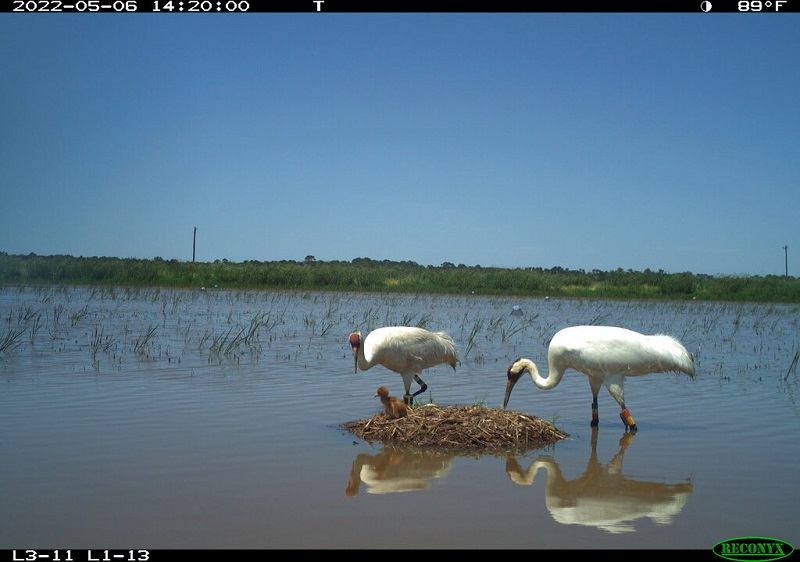
In this image obtained via trail camera and provided by the Louisiana Department of Wildlife and Fisheries, two adult whooping cranes, one female and the other male, stand over a one-day-old chick in Allen Parish, La., on May 6, 2022.
12:04 JST, September 9, 2022
NEW ORLEANS (AP) — A record eight whooping crane chicks have taken wing in Louisiana after hatching in the wild. It’s not just a state record for fledglings of the world’s rarest crane, but one for any flock reintroduced to the wild to help save the endangered birds, the state Department of Wildlife and Fisheries said Thursday.
“That is very exciting. We’re absolutely thrilled that the Louisiana program has done so phenomenally well,” said Anne Lacy, senior manager for North America programs at the International Crane Foundation in Baraboo, Wisconsin.
The previous record was set in 2018, when six wild-hatched birds fledged in the flock that was taught to migrate between Wisconsin and Florida by following ultralight aircraft, Louisiana wildlilfe biologist Sara Zimorski said in an email. That also was Louisiana’s previous record wild fledgling year, at five.
The brown-and-white juveniles which survive to adulthood will be white with red caps and black mustaches and wingtips, and about 5 feet (1.5 meters) tall. Their wingspan can reach 7 feet (2.1 meters) across.
Only about 800 “whoopers” exist, according to the crane foundation. About 500 are in the only natural flock, which winters in Texas and breeds in Alberta, Canada. About 80 are in the Wisconsin-Florida flock, nearly 140 in captivity and seven in an introduced flock that failed in Florida.
Louisiana’s flock now totals 76, said a news release from Wildlife and Fisheries.
Three males and three females raised at the Audubon Nature Institute’s species survival center in New Orleans will join them in November, said assistant curator Richard Dunn.
A fourth female will remain at Audubon for breeding to be sure her good genes meet up with a good match, Dunn said. That’s important because every crane alive is descended from 15 that lived in Texas in 1941. Biologists estimate there were more than 10,000 before habitat loss and overhunting nearly killed them off.
The Louisiana and Wisconsin-Florida flocks are being nurtured in hope of creating a cushion in case anything happens to the natural flock.
Two of the 14 or 15 birds hatched in Wisconsin’s wilds this year will survive to fledging and a third, which broke a wing, is being kept for captive breeding, Lacy said.
She said the foundation just released two yearlings that were raised at the Calgary zoo but couldn’t be sent to Wisconsin last year because of COVID-19 precautions. Seven bred in captivity are to be released later this year.
The Texas-Canada flock is listed as endangered, though the U.S. Fish and Wildlife Service is considering whether to change that to threatened. The “experimental” flocks are classified as threatened because that loosens regulations, making reintroductions more feasible.
“We can’t point out exactly why this was our best year” for fledglings, Zimorski said in the news release. Experience may have played a part — only one of 17 nesting pairs were first-timers, and that pair’s chicks didn’t survive, she wrote in an email.
“Three pairs that had nested unsuccessfully in previous years hatched and fledged chicks this year,” she wrote.
Zimorski said dry conditions during the breeding season, from February until June, may also have played a part.
“I don’t think we’ve had a nesting season during a drought like we had this year,’’ Zimorski said in the news release. “Intuitively it doesn’t seem like that would be good, but according to some colleagues from the U.S. Fish and Wildlife Service, other species of water birds often have really good breeding success in drought years that follow wet years, which we definitely had last year.’’
Last year, 24 pairs mated for what was then a record 14 hatchlings in Louisiana, but only four grew old enough to fly.
Biologists don’t know the sex of this year’s fledglings or those of two birds that hatched last year. The others are 38 males and 28 females.
Whooping cranes mate for life.
“A few birds that nested in 2021 lost their mate and though I think most of them were repaired they didn’t nest with their new mates,” Zimorski said in an email. “Additionally, there were a couple of pairs that nested in 2021 who are still alive and together but just didn’t nest this year.”
Federal and state agencies began Louisiana’s reintroduction in 2011; the first chick hatched in 2016.
This year was the second in a row and the third since 2016 that twins both fledged, the department said. Whooping cranes lay one or two eggs per nest, but generally only one grows up even if two hatch.
"News Services" POPULAR ARTICLE
-

American Playwright Jeremy O. Harris Arrested in Japan on Alleged Drug Smuggling
-

Japan’s Nikkei Stock Average as JGB Yields, Yen Rise on Rate-Hike Bets
-

Japan’s Nikkei Stock Average Licks Wounds after Selloff Sparked by BOJ Hike Bets (UPDATE 1)
-

Japan’s Nikkei Stock Average Buoyed by Stable Yen; SoftBank’s Slide Caps Gains (UPDATE 1)
-

Japanese Bond Yields Zoom, Stocks Slide as Rate Hike Looms
JN ACCESS RANKING
-

Keidanren Chairman Yoshinobu Tsutsui Visits Kashiwazaki-Kariwa Nuclear Power Plant; Inspects New Emergency Safety System
-

Imports of Rare Earths from China Facing Delays, May Be Caused by Deterioration of Japan-China Relations
-

Tokyo Economic Security Forum to Hold Inaugural Meeting Amid Tense Global Environment
-

University of Tokyo Professor Discusses Japanese Economic Security in Interview Ahead of Forum
-

Japan Pulls out of Vietnam Nuclear Project, Complicating Hanoi’s Power Plans


























